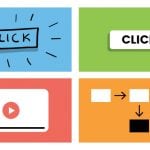Embrace obstacles
Obstacles and setbacks are annoying. But they can lead to great things. Obstacles force us to be creative and can easily be used to our advantage.
Obstacles can improve our performance
Of course obstacles and setbacks are annoying. But at the same time, they can be very helpful. Certain kinds of difficulties can actually improve our performance.
Research has shown that giving students their texts in ugly, hard to read fonts, increases their comprehension of the material. The harder to read fonts force students to slow down and work a bit harder. Thinking a bit more means learning more.
Obstacles and setbacks can also force you to be more creative. Where you might usually get away with a sub-optimal approach, setbacks force you to step up your game. You have to be clever to find a way around the obstacle.
Obstacles and setbacks are annoying (or even painful) occurrences that force us to abandon our preferred way of approaching things.
A great example of how setbacks sometimes lead to new approaches is the way the website 123inkt.nl dealt with an unfavourable verdict in court. After a court case against Samsung, the online retailer, specialised in toner- and ink-cartridges was forced to rectify and call back its (private label) cartridges for Samsung printers. The retailer decided to use the setback as a marketing opportunity. The retailer wrote its rectification, but added a clever twist: “When you return the 123inkt-toners for the Samsung models before the 1st of February, don’t bother removing the printer that’s wrapped around the toner. Just send us your old Samsung printer and we will replace it with a brand-new Brother printer and an extra set of toners. Free of charge.” A great marketing stunt that got the website loads of publicity.
Obstacles can be a great chance to set yourself apart. Disadvantages can be used to emphasize a benefit. In an earlier post, Jeroen already wrote about how Reagan smoothly used one of his biggest weaknesses in the elections (being old) to his advantage. His famous comeback during the final debate, “I will not make age an issue of this campaign. I am not going to exploit for political purposes my opponent’s youth and inexperience”, might well have won him the elections.
Another great example of turning a negative into a positive is the ‘5xD Dishcloth’. A brilliant marketing trick by the Dutch writer Kees van Kooten. While working as a copywriter, Van Kooten had to come up with a clever slogan to advertise a batch of dishcloths. There was one tiny problem with the giant batch of brand-new cloths: during production, they had accidentally not been impregnated. This technique of saturating dishcloths and towels makes them look, and thus sell, better. Van Kooten saw this ‘weakness’ as a strength, for he realised that the usual impregnating of cloths also made them water repellent, meaning that consumers had to wash their towels first before the cloths could properly absorb water and would actually be useful to dry something with. He cleverly branded the cloth the ‘5xD’ cloth, or ‘De Doek Die Direct Droogt’ (‘The Cloth Which Dries Instantly’). It worked. Today, about 60 years later, the DDDDD-towels are still sold under the same name.
Add ‘unnecessary’ obstacles
There’s no point in waiting for bad luck to strike, of course. You can easily introduce small obstacles yourself. Make your challenge more challenging. By adding limitations or a bit of randomness to your thinking process, you’ll increase your chances of finding original solutions.
A little bit of awkwardness helps us to solve problems more effectively. Disrupt your process. Do stupid things that shouldn’t work. Breaking with the usual (thinking) patterns enables you to look at your situation from a different perspective and to think about alternative ways to approach your challenge.
Sadly, we tend to avoid unnecessary obstacles. We feel that these small limitations get in our way of solving the problem.
Why we tend to stay where we are
We like to stay in our comfort zone when trying to come up with creative ideas and clever solutions. We don’t want to overcome seemingly unnecessary hurdles. It’s awkward. It’s annoying.
Consciously adding bits of randomness to your approach should, therefore, be as simple as possible (the simpler it is, the smaller the chance you chicken out of it).
Make it as easy as possible
A great way to quickly and easily introduce some friendly obstacles to your challenge is by using simple thinking techniques like ‘escape‘, ‘random image’ or ‘make it worse’. It seemingly makes your job a bit harder, but actually makes finding original ideas a lot easier.
Because even the minimal hassle of looking up thinking techniques and figuring out which ones are best suited for your challenge can keep you from adding these artificial obstacles, we created something even better: a digital facilitator which serves you some random, yet perfectly suited thinking techniques to creatively tackle your challenge.
Currently, the application is only available in Dutch, but if you’re interested in an English version, be sure to let us know.
Experience it yourself
Of course, even if it’s easy, most people will only actively introduce obstacles in their quest for solutions if they’ve experienced that it actually works. So clearly you should experience the power of a bit of randomness first-hand. We’d love to let you experience the power of thinking techniques (artificial obstacles) and creative problemsolving. We offer various workshops on creative problemsolving and a comprehensive Innovation Course. Send us an email or give us a call on 0031-103 070 534 and we’ll happily tell you all about the different possibilities.
Want to hear more about how obstacles can inspire creativity? Check out this great TED-talk by Tim Harford:





